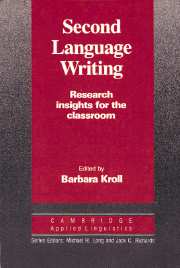Book contents
- Frontmatter
- Contents
- List of contributors
- Series editors' preface
- Preface
- Introduction
- I PHILOSOPHICAL UNDERPINNINGS OF SECOND LANGUAGE WRITING INSTRUCTION
- II CONSIDERATIONS FOR WRITING INSTRUCTION
- Chapter 7 Composing in English: effects of a first language on writing in English as a second language
- Chapter 8 The teaching of topical structure analysis as a revision strategy for ESL writers
- Chapter 9 What does time buy? ESL student performance on home versus class compositions
- Chapter 10 Feedback on compositions: teacher and student verbal reports
- Chapter 11 Teacher response to student writing: focus on form versus content
- Chapter 12 Responding to different topic types: a quantitative analysis from a contrastive rhetoric perspective
- Chapter 13 Writing with others' words: using background reading text in academic compositions
- Index
Chapter 13 - Writing with others' words: using background reading text in academic compositions
Published online by Cambridge University Press: 05 October 2012
- Frontmatter
- Contents
- List of contributors
- Series editors' preface
- Preface
- Introduction
- I PHILOSOPHICAL UNDERPINNINGS OF SECOND LANGUAGE WRITING INSTRUCTION
- II CONSIDERATIONS FOR WRITING INSTRUCTION
- Chapter 7 Composing in English: effects of a first language on writing in English as a second language
- Chapter 8 The teaching of topical structure analysis as a revision strategy for ESL writers
- Chapter 9 What does time buy? ESL student performance on home versus class compositions
- Chapter 10 Feedback on compositions: teacher and student verbal reports
- Chapter 11 Teacher response to student writing: focus on form versus content
- Chapter 12 Responding to different topic types: a quantitative analysis from a contrastive rhetoric perspective
- Chapter 13 Writing with others' words: using background reading text in academic compositions
- Index
Summary
Successful academic writing involves, among other things, the ability to integrate information from previous researchers in relevant areas of study. Even the most original academic paper integrates facts, ideas, concepts, and theories from other sources by means of quotations, paraphrases, summaries, and brief references. Yet this common feature of academic writing has rarely been directly studied either in the writing of native or nonnative speakers of English. Even rarer is documentation of the highly complex processes followed by academic writers using background sources – processes that involve reading, understanding, learning, relating, planning, writing, revising, editing, and orchestrating.
It has been suggested that the ability to use written sources appropriately may develop over time. In a report for the Schools Council of Great Britain on the written language of students 11 to 18 years of age, Britton et al. (1975) propose a theoretical scale of “degrees of copying.” The scale begins with mechanical copying, and continues with copying for some purpose – for example, because the writer likes or agrees with the original, or because the writer is required to present information exactly. Actual composing begins further along the scale with summarization and expansion of written ideas, followed by imitation of style, and finally synthesis, which Britton et al. (1975) consider “rare in school work” (p. 46). They suggest that writers may have to pass through earlier stages before reaching the final stage of synthesis.
- Type
- Chapter
- Information
- Second Language Writing (Cambridge Applied Linguistics)Research Insights for the Classroom, pp. 211 - 230Publisher: Cambridge University PressPrint publication year: 1990
- 55
- Cited by



